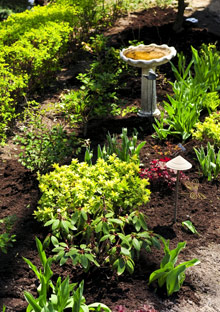From Seeds to Edible Greens: 4 Easy Vegetable Garden Rules

Photo: © 2009 Jupiterimages Corporation
Forget the myth of the $20 tomato—raising your own fresh, luscious, sun-ripened fruits and vegetables isn't the backbreaking, budget-busting hassle you'd think.
I hate to break it to you, but the best-tasting food in the world cannot be bought at any price. Not even the nicest farmers' market produce can compete with salad greens that land in the bowl a few minutes after being picked, or tomatoes sliced still warm from the sun, or lemon basil leaves thrown onto roasted vegetables within a moment of being pinched off their stems. If you want food this fresh and flavorful, you have to grow it. And if you are after culinary adventure and consider the kitchen an endless frontier, that, too, argues for growing your own food. Farmers must be conservative and plant those vegetable varieties they can transport and sell. If there's no demand for hairy melon from customers, they're not going to grow hairy melon, no matter how wonderful it may be in a curry.
Home gardeners, on the other hand, are free to experiment with strange Indian gourds, odd Italian leaf broccolis, and strawberries so delicate they seem to consist entirely of perfume. Brilliant seed purveyors like Fedco Seeds and Baker Creek Heirloom Seeds are constantly seeking out the new, the forgotten, the extra-flavorful, and the just plain weird. With even organic seed available for two or three dollars a packet, this is one of the few areas of life where crazy extravagance is the only sensible way to proceed.
Plus, if you hope to eat sustainably as well as beautifully, few things are kinder to the planet than to grocery shop the backyard. Unlike industrial farms, which collectively use tremendous amounts of fossil fuels and cause an array of ecological problems with their overreliance on artificial fertilizers and soil-crushing machines, the home garden requires nothing that upsets the balance of nature. It requires almost no energy input, either, other than the energy of the gardener.
Ah, but that's the problem, you might say! Gardening is hard work, right? Actually, the most successful gardening methods require the least labor. If you manage your garden intelligently, it can take less time than pushing a cart down your supermarket's miles of aisles twice a week. In other words, it's easy to grow a flood of beautiful food. Of course, there are many 400-page guides on the bookstore shelves that make it sound as if a vegetable garden has to be managed with the same precision as a graded college chemistry lab. Ignore them. Here's the cheerful truth: Push a seed into the earth and it wants to grow. Here is something else the how-tos may not make clear: There is no one right way to make a vegetable garden. The finer points will vary tremendously depending on where you are doing it.
But the basic principles are simple:
1. Pick a spot, any sunny spot, for your garden. It doesn't have to be large. My first garden was just six by ten feet. It's safe to say that as a first-time gardener, you will be astonished at the amount of food that can be grown in a small space.
The spot also does not have to be perfect in other ways. If your yard is contaminated by lead, or the drainage is terrible, or the ground is undiggable, raised beds are probably the answer. If you are gardening in an arid place, you can always plant your seeds in trenches. Even if your soil has the texture of beach sand or modeling clay, you can eventually turn it into gorgeous loam by adding lots of organic matter to it, something we'll discuss in a minute.
A fence, however, may be a prerequisite for happiness, depending on the ambitions of your local deer and rabbits. And the sun is not negotiable. In my experience, even vegetables that don't like heat need a full day of sun to thrive.



